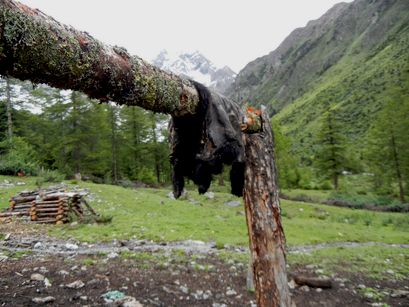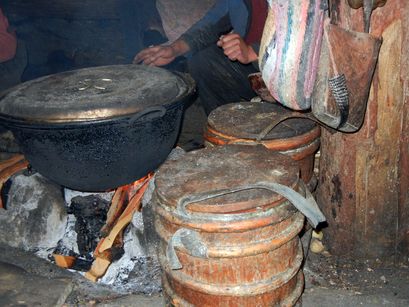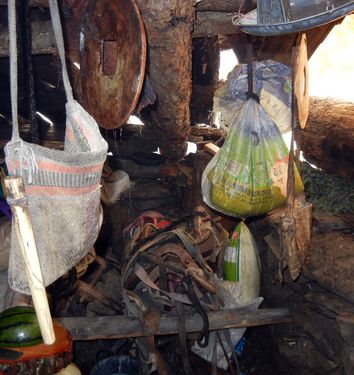Content created: 2005-07-21
File last modified:
Go to
Essay 1,
Essay 2,
Metal Ages,
Mesopotamia.
The Neolithic (Essay 3)
Living the Revolution
D. K. Jordan
Outline
- Foragers versus Farmers: Two Life-Styles (Link)
- Agricultural Society and Culture (Link)
- The Neolithic Gets Complicated: Çatal Hüyük, Turkey (Link)
- Personality in Agricultural Societies (Link)
- Pastoralism (Herding) (Link)
- Personality Again: Herding, Farming, and Values (Link)
- Review Quizzes (Link)
1. Foragers versus Farmers: Two Life-Styles
The development of agriculture did not simply happen. We have seen that it involved both human understanding and biological transformations in the plants and animals domesticated. Also part of the story were certain kinds of social, cultural, and personality characteristics that facilitated adaptation to farming and herding, and certain kinds of social, cultural, and psychological effects produced by the constraints of farming and herding.
Scholars are still sorting out the complex interaction between the way a group makes its living and the way in which it organizes society, shares understandings, or rears children. However it is already clear that there are some important differences between agricultural groups, pastoral groups, and foraging groups. In spite of the fact that some foraging groups have lived in ways that resemble the ways some farming groups have lived, for the most part the two ways of life are radically different. The “Neolithic revolution” therefore, despite the existence of part-foraging, part-gardening adaptations, like the Natufians or the Mandan, still represents a cultural, social, and psychological change in the human condition, and not merely a material one. We move now to an exploration of some of the implications
A. Agricultural Society and Culture
Population Density. Agriculture normally supports a far greater population per area of land than does hunting and gathering. Foragers depend on the chance occurrence of edible plants among many inedible ones and on whatever wildlife feeds on the particular plants (or on other animals) that happen to occur in the area. Most of their environment, despite the variety it provides, is unhelpful to them in satisfying their food needs. Agriculturalists, on the other hand, can fill an area of land with almost nothing but food-producing plants. And greater availability of food makes possible higher density of population. (Usually this entails a decrease in the variety of the diet, and therefore poorer nutrition, but more total calories, more dependably available.)
Foraging groups tend to be small, typically bands of one or a few families, sometimes congregating together briefly in larger groups. Agricultural societies are nearly always much larger. Even if the immediate living unit is an isolated farming family, it is typically in very frequent contact with other farming families in its vicinity. And it is both possible and common for farming families to live together in hamlets and villages. Farming also provides the food base for cities, ancient and modern.
Access rights. A tremendous number of additional contrasts follow from this difference in population density. For example, in an agricultural community there must be clear understandings about who is entitled to which land, which water, and which harvests, about who is supposed to work on which crops. And there must be people empowered to do something about it if the understandings are violated. An agricultural community typically needs a more elaborate organization of political power than does a foraging band.
Immobility. Besides being generally larger, agricultural populations are comparatively immobile. Foragers, in contrast, can rarely remain permanently in the same location. [Note 1] If a foraging band or even individual has a conflict with another, it is sometimes possible to move into a new territory at least for a while. If an agricultural group (a family, say) finds itself in conflict with its neighbors, it is not so easy to move. The crops are tied to the ground in a complex planting-and-harvesting cycle (with something growing or in storage all the time), and equipment necessary to farming (millstones, winnowing baskets, plows) is often heavy or bulky and cannot easily be transported. Even as living near each other leads to conflicts, not being able to move freely makes it imperative that these conflicts be resolved!

Top View of a Coarse Millstone. Grain is placed on this surface, and a second stone set on top of it is rotated to crush and abraid away the chaff, or, with finer millstones, to pulverize the grain itself into a coarse powder to facilitate cooking. Very little agricultural equipment is actually made of stone, but almost all of it is far too heavy or two awkward to carry around easily, and therefore tends to be incompatible with a nomadic way of life. (Hong Kong, XIXth Century)
photo by DKJ
Even small, relatively autonomous communities of the Neolithic world must therefore have had various kinds of peace-keeping (and war-making!) arrangements; otherwise the inhabitants would readily have been driven back into foraging bands that could move away from each other. In historically known agricultural communities of this scale (such as the Hopi and other Pueblo peoples of the American Southwest) we see the development of ethical systems and of political offices with important peace-making functions, even though we do not necessarily see strongly coercive power in the hands of designated leaders.
Stuff (Especially Pottery). Another result of immobility is that people accumulate things. Carrying luxuries around turns them into burdens, and foragers (and to some extent nomadic herders) own little that is not immediately useful. (Since herders can use animal labor in moving from place to place, they tend to accumulate more possessions than foragers do.) Settled populations, on the other hand, can accumulate material goods almost without regard to weight or bulk. In most parts of the world, pottery appears in the archaeological record at about the same time as farming. Serious work in metals and the carving of large stones also appear only after farming does. The reason is simple: Only the agricultural adaptation normally allowed the accumulation of material goods of any weight or bulk.
Material goods, like crops, also need protection, of course. Once again, political organization is necessary. Indeed the idea of private property becomes strikingly more important in an agricultural community simply because there is so much more property in total and, accordingly, so much more concern about it. There is much truth to the stereotype of foragers as people who share and agriculturalists as people who hoard. (Contrasting to both are herders, stereotypically people who raid.)
The ability to accumulate property is also the ability to be rich or poor. In foraging communities some people are better hunters than others; some people find or process plant products more successfully; some people are healthier than others; some people know more about medicinal plants; some are more persuasive; and some have more kinsmen than others. But there is very little difference in wealth as measured by tangible, physical objects. The ability to stay in one place and accumulate goods, however, almost inevitably entails differences in how much and what is accumulated, and differences in material wealth begin to appear, together with attitudes about possession, sharing, and theft.
Social stratification. Social stratification is importantly based on differences in wealth and power, and some degree of social stratification is a common characteristic of agriculturally-based societies. Social stratification is not necessarily characteristic of all agricultural societies, and it is by no means entirely wanting in foraging societies, but archaeologists and ethnologists have both noted that there is a very much higher probability of finding clear social stratification in agricultural societies than among foragers. Most early Neolithic communities seem to have been tribes or chiefdoms, and despite being settled, do not in fact show significant differences in social status. On the other hand most communities in the Bronze Age (the period following the Neolithic in most regions) are fully class-ridden, headed by a powerful monarch at the top, served by comparatively powerless peasants, with slaves at the bottom. [Note 2]
The term tribe usually refers to a horticultural population numbering anywhere from a few hundred to a few thousand people. In the broadest sense, the term “tribe” has frequently been applied to groupings of exogamous bands in possession and control of their own extensive territory, whose members share a common genetic, cultural, and linguistic heritage and explicitly recognize some affinity toward one another. The several communities making up a tribe are not united under a sovereign governing authority. The tribe is sometimes united by the possession of a coordinating political system, such as a tribal council and/or chieftain, but top levels of the structure tend to be weak except when temporarily united for warfare.
A “chiefdom” in contrast, represents an increase in scale over a tribe, usually with a chief whose position is hereditary and whose power is great. Typically a good deal of economic exchange occurs between a chief and ordinary members, with gifts passing both ways in a redistributive system that bolsters the chief’s power. In such a context the chief has the ability to organize and deploy public labor and subsidize specialists, often at the redistribution center; social inequality stems from the creation of a “nobility,” usually starting with the chief's immediate family and kinfolk. Thus incipient social class is visible. Probably most early Bronze Age communities were chiefdoms in organization. Some Neolithic communities such as Çatal Hüyük, may also have been. Later Bronze Age polities came to be states and even empires, as we shall see.
Return to top.
B. The Neolithic Gets Complicated: Çatal Hüyük, Turkey
Earlier we mentioned the Chinese site of Bànpō as a fairly typical Neolithic village in a world of similar small villages very much like it, each apparently more or less autonomous, each showing some only very modest differences in wealth.
But some Neolithic sites are much different, and challenge the stereotype of Neolithic simplicity. One of the most remarkable Neolithic sites ever excavated is Çatal Hüyük [cha-TAHL hee-YEEK], located in what is today south central Turkey. Çatal Hüyük (sometimes spelled Çatalhöyük or Çatal Höyük) is about ten times as large as settlements anywhere else in the Near East at that period. Archaeologists often give it the title “the first city” because it is much larger than other Neolithic sites of its age or earlier. Something special was clearly going on here!
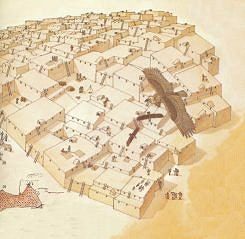
Artist's Rendition of Çatal Hüyük
Çatal Hüyük was discovered in the 1950s, but only about four percent of the site was excavated at that time. In the mid-1990s excavation began again and continues, but our picture is still by no means complete. Excavations carried out so far show that by 6150 BC (while the Natufians at Abu Hureyra were moving rapidly from “terminal foraging” towards “Pre-Pottery Neolithic”), Çatal Hüyük was far larger than other settlements. Twelve excavation levels record about 800 years of habitation at the site. In all levels it was a mass of houses made of sun-dried mud brick, built against each other with shared walls. Access to each house was through a trap door in the roof and a ladder, and access to the city itself was by ladders up the outermost house walls, and then over the roofs to the various houses. With no doors at ground level, such a complex would be easily defended, particularly by a population much larger than the forces any potential enemy would be likely to bring against it. However there are no signs of warfare at Çatal Hüyük, and it is not clear that the arrangement was intended to be defensive, although other reasons seem unconvincing.
The roofs were apparently not all the same height, which allowed all but the lowest to have small windows near the ceilings to admit light and fresh air. When a house was destroyed or abandoned, it would fall in, and the space would serve as a trash heap for a while. Eventually a new house would be built on top of the trash, so that over time the vast complex became a higher and higher mound of rubble with rooms on top.
The agricultural base of Çatal Hüyük included the usual Near Eastern cereals (barley and wheat) as well as peas and vetches, and various nuts. Evidence suggests that beer was brewed, of course, although the recipe is lost to us. Hunting was practiced, but domesticated sheep and cattle were also kept. Tools made of obsidian, the volcanic glass that is capable of being chipped to a cutting edge sharper than modern broken glass, have turned up in such large numbers as to suggest that Çatal Hüyük may have been a central trading point for obsidian blades and mirrors, and an obsidian trading network has been postulated extending from western Turkey to Cyprus and the eastern Mediterranean coast. Those who received obsidian apparently received it in exchange for other types of stone, sometimes worked, and shells, among other things. Some specimens of turquoise have been identified as coming all the way from the Sinai peninsula in eastern Egypt. Some fragments of woolen cloth have been preserved, but how if at all they figured in the trading network is unclear.
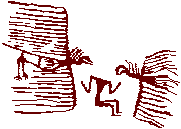
Çatal Hüyük Wall Motifs
Intangible Trade Goods? All of this is impressive, and would surely have dazzled a visiting Natufian. But none of these features explain Çatal Hüyük’s enormous size compared with other settlements. It is possible that there was trade also in some less tangible good. We have historical examples of settlements that functioned as religious centers and received material goods in exchange for healing, fortune telling, magical objects, or blessings. Modern “sacred cities” like Vārānasi (Benares), Lourdes, or Makkah (Mecca) derive much of their income from pilgrims who do not take away substantial physical goods. Possibly Çatal Hüyük did so as well, and we will need to hypothesize “intangible trade goods” to produce a convincing model.
What is the evidence? Nearly thirty percent of the rooms excavated in the 1950s were designated “shrines” by the puzzled archaeologists on the basis of their odd decoration and contents. The plastered walls bear paintings and sculptures of bulls’ heads, dead bodies, vultures, and “goddesses,” sometimes shown giving birth to bulls. The plastered walls bear paintings and sculptures of bulls’ heads, dead bodies, vultures, and “goddesses,” sometimes shown giving birth to bulls. Breast-like sculptures protrude from corners of some rooms, but vultures’ beaks are found where the nipples should be. Dead bodies are buried beneath plaster platforms that in other respects seem to have been used as altars.
The stress upon vultures in the wall paintings suggests that vultures may have been allowed to clean the bones of the dead before burial. In any case, the head of the body was usually removed before the body was buried, and some murals feature headless human figures. Small, possibly votive, statues of clay and stone represent both bulls’ heads and enormously fat “goddesses,” reminiscent of Gravettian “Venus figures” of the European Upper Paleolithic. One white marble figure shows a man wearing a leopard skin as a headdress. In many “shrine” rooms real bull skulls were plastered and decorated, or plaster bull’s heads were decorated with real horns. No two “shrine” rooms are identical, but they share enough features that they are clearly part of the same general system of activity.
One possibility is that the town, or anyway the excavated part of it, was a religious center, perhaps, like Chinese Buddhist monasteries in much later times, making its living partly through the sale or rental of religious paraphernalia and by providing funeral services and disposal of the dead.
Çatal Hüyük is of course special, by no means a “typical” Neolithic community. It is too big. That is part of why it is famous. But it is also too odd. If it were a Bronze Age settlement, its size would be less impressively distinctive, for, as we shall see, “cities” become the mark of the Bronze Age. Its oddness, however, would be just as challenging.
Return to top.
2. Personality in Agricultural Societies
What sort of person was a Neolithic agriculturalist? We have seen that differences in social structure and culture seem to flow simply from the high density and relative immobility of an agricultural population. We can readily imagine how personality differences might also result both directly from these facts of density and immobility and indirectly from the social and cultural features associated with them.
For example, in an agricultural society, where disputes must be avoided or peaceably settled, discipline and obedience to authority are extremely important. Discipline and obedience not only help prevent disputes from arising in the first place; they also make the resolution of disputes much easier. Not only is there established political leadership in most agricultural societies, but parents must train their children to be obedient to leaders, and adults must expect to obey higher authorities in their society. The details of how personality is formed in children make up an important field of study (called “socialization”), but the point here is only this: more complex and more frequent human contacts with a wider variety of people living close together make discipline and obedience more important issues than they would otherwise be. If population density and immobility go up, then so must the social and psychological means of coping with them.
Patience. Another feature of agricultural life also makes discipline adaptive: crops do not immediately pay a farmer back for the work put into them. A forager is usually rewarded the same day for effort expended. A hunter is nearly always rewarded at least once every few days with a successful kill. A gatherer usually finds what is sought fairly quickly. If this were not so, the foragers would starve to death. Farmers, on the other hand, must wait months, sometimes years, before they see the fruits of their labors. They must not expect immediate gratification of their desires, but must plan ahead and have confidence that in the end the effort they are putting into planting and tending crops will be worth it. Here too discipline and obedience are necessary.
The hunter must encourage children to be brave and self-reliant in situations that are frightening and dangerous: that is how animals are caught and killed and how hunters and gatherers avoid being bitten, scratched, trampled, or gored. No two kills are alike, and the young hunter must be encouraged to be decisive and quick enough for any circumstances. The young farmer, on the other hand, must be motivated to work without either the threat (and thrill) of immediate danger or the promise of immediate reward. The farmer must follow procedures that are not suggested by a quick wit and rapid response, but by the collective wisdom and experience of the group. From Classical antiquity through the early years of the XXIst century social theorists generally tended to see the beginnings of agriculture as the moment in history when boorish vigor was supplanted by civilized self-restraint; it is not hard to see where they got the idea.
Wealth. But there is more: The proliferation of leadership and mediation roles in agricultural communities requires that at least some of the members of a community desire these positions and be willing to fulfill them. Often leadership is also linked to possessions. In agricultural communities for example we should expect to find not only wealth and differences in wealth, but also the desire for wealth and interest in differences in wealth.
Ethnographers have observed that the uncertainty whether a given hunter will kill anything or not in a given day, or whether the quest to find shell fish or plant food will succeed, seem to have led foraging peoples to place a high premium on generosity, as we noted earlier. Most meat killed by hunters is divided among many or all members of the hunting band, often following lines of kinship ties (as was traditional among the San of Namibia and Botswana, for example, or the Pygmy populations of central Africa or the arctic Eskimos).
The adaptiveness of the custom of sharing food in a foraging group is obvious, and presumably groups that did not have such a custom would sooner or later have some of their members starving to death because they were too ill or too old to fetch their own food and water, or because they were simply unlucky
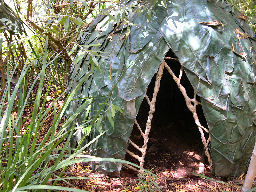
Typical hut of the Ituri Forest Pygmy peoples of the Congo. Foraging populations typically place a great deal of stress on food sharing and tend to honor people particularly adept at bringing back a great deal of food to share. However a strongly egalitarian ethos also tends to restrict claims of superiority even when they are based on hunting prowess. (Ituri Forest, Congo, Reproduction)
photo by DKJ
Sharing & Cooperation. Among agriculturalists, however, the day-to-day sharing of produce, except within families, is much rarer, perhaps because individual disasters are rarely as sudden, as unpredicted, or as extreme as in foraging groups. [Note 3] On the other hand, among agriculturalists the necessity of large amounts of labor during planting and harvest leads to mutual exchanges of labor between one farming family and the next in these periods. Sharing is a particularly valued trait among foragers, a much less important one among farmers; but cooperation is usually a highly valued trait among farmers (and among hunters who use techniques that require participation of large numbers of people in pursuit of their prey).
Sharing and cooperation do not just occur naturally in the interest of efficiency. They must be psychologically motivated, like any other behavior. Foragers must be motivated to share what they are able to collect, and agriculturalists must be motivated to cooperate with their neighbors during planting and harvest. Sharing and cooperating must be part of normal life in these two kinds of societies, taught to children as they grow up. We should expect that child training in the two kinds of societies would exhibit certain differences because of this.
There is of course tremendous variation from group to group and from individual to individual, and therefore generalizations such as those we have been making are not very useful in understanding the behavior of some particular group of people. The point is that in general successful adaptation to agriculture entails the emergence of personality structures and values that are capable of handling delay of gratification, obedience to authority, interest in material goods, cooperation with other people, and the desire to occupy a wide variety of social statuses. Successful adaptation to foraging, on the other hand, rewards a personality that is independent and self-reliant, that desires to fulfill the role of providing and sharing rather than of hoarding material goods, and that has a high tolerance for the uncertainty of not knowing just what, if anything, will be on hand to eat tomorrow. The agricultural revolution has interested archaeologists not merely because it was a change in where food came from; it was also a change in the social, cultural, and psychological possibilities open to people.
Return to top.
3. Pastoralism (Herding)
We should not leave the subject of foraging and agriculture without mentioning herding (also called pastoralism). Most agriculturalists raise a few domesticated animals. We have seen that cats are critical if one raises and stores grains. Some foragers also keep a few animals. (Dogs are a frequent favorite.) But as a way of life, herding is an adaptation found particularly in cold or semiarid areas where the local ecology produces pasturage (such as grass) but where it is not usually rich enough to support a substantial population through horticulture or agriculture.
Although both hunting and herding involve making a living from animals, herding is quite different from hunting. Hunters do not cultivate animals; they merely kill them. The welfare of the target animals is rarely a consideration. Juveniles, for example, being weaker, tastier, and easier to hunt, are killed with eagerness. Herders, on the other hand, deliberately cultivate their animals. Juveniles are normally protected so that they will become adults. Care is taken to avoid slaughtering animals unnecessarily. And a diminishing herd is taken as a danger signal of some importance. Herders, unlike hunters, seek to protect their animals from other predators. [Note 4]
Like hunters, herders must orchestrate their lives to the needs of their animals, but while hunters simply follow the animals wherever they lead and can be found, preferably in large numbers, herders take it upon themselves to lead their animals to areas where they can flourish as much as possible. Sometimes the animals are moved from their natural environment into areas more comfortable for human habitation. If it were not for human guidance, it is unlikely that the animals would be able to survive in many such climes. An example would be the Viking occupation of Iceland, where pastoralists engaged in summer “grass farming” in order to accumulate sufficient feedd stocks that could be fed to their animals during the long winter months.
Transhumance. Typically pastoralism involves a series of encampments, varying by season, as the pasture resources of different areas are used up and must be left to recover. Usually there is at least a winter encampment or village and a summer one, and the group moves back and forth between the two each year, an adaptation called transhumance. [Note 5]
Example: Yak herders. Yak herders of Tibet and Nepal were still a typical nomadic herding society when they were described by Robert Ekvall in a book provocatively entitled Fields on the Hoof (1968) [Source]. The Tibetan herders that Ekvall studied organized their lives around the necessity of moving their animals very frequently, as the resources of any given area became exhausted. With frequent moves, they lived in portable tents and avoided excessive personal possessions. When they had the option to stay put, they built more lasting shelters which, archaeologically, would have looked Neolithic. (The shelters in the pictures here are of this more permanent kind.)
Normally, three moves [per year] is the very minimum and eight a maximum, but emergencies may cause a community to move a dozen times a year. At the other extreme, one tribe in southern Tibet [where conditions are better], for example, moves once every three years and builds half-cave, half-sod houses at each move. (Ekvall 1968: 33)
The community was sometimes more compact spatially than at other times, for it had to adjust itself constantly to new terrain; however community members tried to stay together and to keep their social contacts intact. They even tried to maintain the same general spatial relationships when they could.
When a community moves out of winter quarters to begin the seasonal search for the best pasturage, the families retain their winter-quarters location relationships. If they have been organized as an encampment … commonly called “tent circle” … they continue that pattern of placement throughout each of the moves; if they have camped separately, yet having a neighborhood relationship as a group, they maintain the same pattern and neighborly relationship: within long earshot of each other, or at least within a few minutes ride.
Occasionally, as they move, the pattern is adjusted to topography. Where it is steppe-like, or wide valleys, the tent neighborhood groups in a circle, but where it consists of narrow ravines and sharp ridges, the tents may be scattered along a valley and its connecting side valleys—keeping relatively close, however, so that their herdsmen meet during the day, or combine in cooperative herding. (Ekvall 1968: 33)
Return to top.
4. Personality Again:
Herding, Farming, and Values
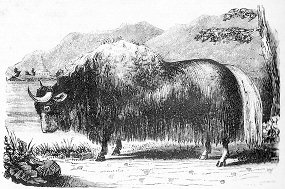
Domesticated YakAbove: Travelers like XIXth-century Sinologist S. Wells Williams were enormously impressed at the variety of uses to which yaks were put in Turkestan and Tibet.
Below: A modern yak herder in the eastern Himalayas tends his animals in their summer pasture.
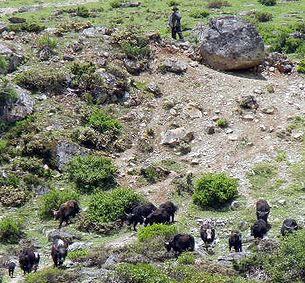
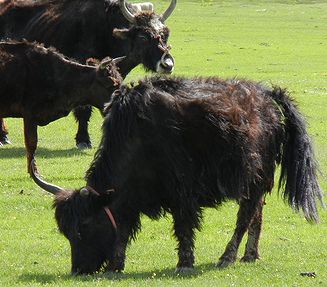
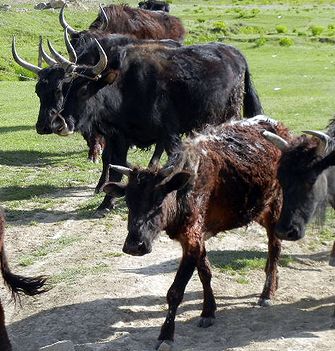
photos by DKJ
In the mid-XXth century, a number of anthropologists participated in a joint effort called the “Culture and Ecology in East Africa Project,” under the direction of Walter Goldschmidt of UCLA. One of the project’s goals was to investigate the effects of different subsistence adaptations upon culture, social structure, and personality. Goldschmidt was able to point to a number of significant differences between pastoralism and agriculture (1965) [Source].
As in the case of foraging, pastoralism requires that people be mobile; it therefore does not allow the investment of a large amount of energy and wealth in material goods (other than animals). Unlike both foraging and agriculture, however, the concern with the welfare of animals requires particular attention to rights in water sources and, to a lesser extent, salt sources. Elaborate conventions and frequent contention over the use of oases are a constant concern in much of the Arab world, for example, with its long traditions of pastoralism.
War and raiding. Pastoral societies also seem to be more prone than agricultural ones to raiding and local warfare. A number of features of herding may be related to this. Goldschmidt notes the fact that, because stealing herd animals is easy (at least compared with stealing fields), the temptation to raid is great and the necessity of defense is correspondingly great. Furthermore, the movement of pastoral peoples means that a group’s vulnerability to attack differs at different times. The strategic relationship between groups is therefore constantly changing, and even a strong group has moments of weakness when its resources are not conveniently arranged for defense. In such a situation, long-term military stalemates are difficult to maintain.
Quite aside from the logistics of the situation, organization for defense requires techniques different from those that are available to the farmer. A farmer can organize defense on a regional basis (although not all farmers do it this way). Pastoralists, because their spatial relations are ever changing, must depend upon organization through kinship ties or similar, non-regional links. Goldschmidt writes:
Two mechanisms exist in Africa; segmentary lineages … and age grades. The former, in its finest form, such as that of the Somali, can unify a large nation while preserving the independence of action of the individual household. The latter creates special institutional means for unifying a wide region for military action. (Goldschmidt 1965: 404) [Source]
Segmentary lineages are complex genealogy-based alliances that are normally dormant, but can produce instant armies when a genealogically appropriate member calls on his sub-lineage mates for assistance. Age grades are associations based in periodic initiation of roughly same-age children (or sometimes adults), and they include the duty of mutual assistance. Neither lineages nor age-grades depend on geography, so it is easy to see how these can serve as social links for people without constant neighbors, i.e., for pastoralists.
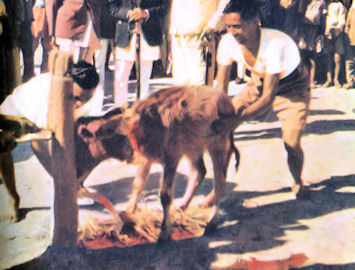
Goat Sacrifice in NepalThe ritual sacrifice of animals for religious or magical purposes is not unexpected in pastoral societies, in which animals are among the most valuable possessions, but the practice is not uncommon among farming peoples as well. The association of blood with life amplifies the symbolic potential of the practice.
Division of labor. For reasons about which specialists disagree, herding societies uniformly assign the tasks of animal care to men (and occasionally partially to little boys) rather than to women. One opinion is that this is due to the need of greater physical strength in some aspects of handling herds and in defending them against theft. Greater physical strength is not needed in all aspects of herding, however, and obviously not all men are strong or all women weak. Another opinion is that the mobility needed from a herder is incompatible with bearing and tending children. If some aspects of herding are going to be men’s work, it is argued, then the use of little boys instead of little girls when children are involved can be explained by reference to the division of labor by gender already established among adults and the practical need to train children in the same spheres in which they will be expected to function as adults.
Male dominance among pastoralists. Whatever the reason for this link between men and herds, pastoral social organization displays a marked tendency toward male-centeredness in group membership, in residence patterns, and in the distribution of authority. The typical pastoral society is one in which women are in a clearly subordinate position to men. Often households are dominated by one senior male, with several wives and children. Boys are given responsibility for the day-to-day maintenance of the herds, but always under the tight control of an authoritarian father, a kind of a child training that Goldschmidt describes as “combining both the independence of action and the acceptance of authority” (1965: 405) [Source].
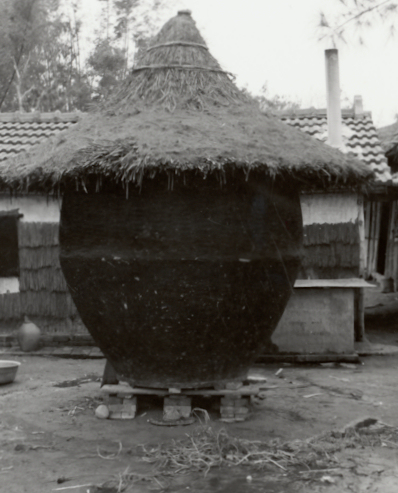
Tar-Coated
Wattle-and-Daub GranaryAgriculturalists face the problem of storing their harvest for gradual use, and a major threat to stored grain is rodents and various grain-loving insects. This tar-coated, straw-roofed granary is intended to keep out moisture, insects, and rats, and it is raised up to avoid ground moisture. Photographed in Taiwan in 1966, it is typical of such structures around the world.
A critical line of defense against rodents was (and is) the domestic cat. Cats seem to have been domesticated in most regions at about the same time as grain. (It seems that civilization depends upon cats, just as cat owners have always told us.) Some writers have speculated that this is one reason for the importance given to cats in the art and religion of ancient Egypt, where countless statues were made like the one below.
But effective as such measures may be against moisture, insects, and rodents, they provide no defense against human predators, including governments, neighbors, or passing pastoralists, who may confiscate grain supplies or set fire to them.
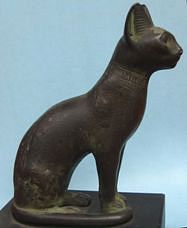
photos by DKJ
Male dominance, militarism, and independence are found to be particularly common themes in pastoral male child training. Goldschmidt characterizes the personality attributes of the ideal male in most pastoralist societies this way:
… a high degree of independence of action; a willingness to take chances; a readiness to act, and a capacity for action; self-containment and control, especially in the face of danger; bravery, fortitude, and the ability to withstand pain and hardship; arrogance, sexuality, and a realistic appraisal of the world.
The masculine orientation of the social system, together with aggressive independence, supports a pattern of sexuality in males which finds many recurrent expressions among pastoralists: the high incidence of polygyny, the overt sexuality of men; premarital sexual freedom [for men], and jealous protection of wives. This emphasis on sexuality of males makes the acquisition of women a matter of prime importance [to male prestige], so that, though women have low social status, they have a high social value. (1965: 405)
Robert Edgerton, in another paper for the same project, describes some of the other findings on the differences between farmers and herders: He writes that some of the predictions that the project verified about the differences
are relatively obvious —such as the fact that the farmers did indeed define wealth in terms of land whereas the herders did not. Others were more impressive: as we expected the farmers divine [i.e., tell fortunes] and consult one another, the herders act individually; the farmers do value hard work, the herders do not; the farmers are indeed relatively more hostile and suspicious of their fellows than [are] herders. Some confirmed differences even extended as far as personality; e.g., the farmers tend to be indirect, abstract, given to fantasy, more anxious, less able to deal with their emotions, and less able to control their impulses. The herders, on the contrary, are direct, open, bound to reality, and their emotions, though constricted, are under control. It is apparent that even this crude analysis points to meaningful and predictable differentials between farmers and herders. (1965: 446) [Source]
The culture and ecology project dealt with only four groups. It was only a beginning, and specialists have been sadly slow to extend its range to more data. Given this start, it is easy to speculate (as we did concerning foragers and farmers) about the kind of society, culture, and personality that, all other things being equal and under most circumstances, might be expected to fit most congenially with such a subsistence adaptation as foraging, herding, or farming. Ethnologists and historians are just beginning to work out the details even for living peoples.
It is already clear, however, that there are potentials, pressures, and problems that are peculiar to each of these three kinds of adaptation, and that the dawn of agriculture in the archaeological record represents not only a major transformation in the source of human food, but also a transformation in the available range of social, cultural, and psychological arrangements that characterize human communities in the millennia between that time and the present. The ideas and values of agriculturalists and pastoralists —the ones we see reflected in most of humanity’s earliest written records— are not those which characterized humans through most of the human career.
Two interactive multiple-choice review quizzes are available for this reading. (Quiz 1, Quiz 2)
Return to top.
Go to
Essay 1,
Essay 2,
Metal Ages,
Mesopotamia.






